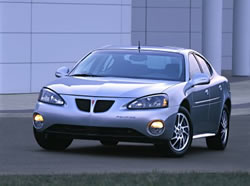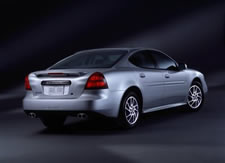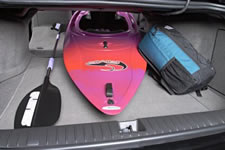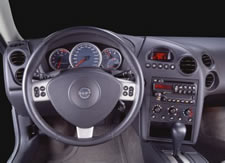|
 For
decades now the Pontiac brand from General Motors has favored racy cars with sporty
styling and muscular powerplants in a collection tagged with legendary nameplates
like Bonneville, Grand Am and Grand Prix. For
decades now the Pontiac brand from General Motors has favored racy cars with sporty
styling and muscular powerplants in a collection tagged with legendary nameplates
like Bonneville, Grand Am and Grand Prix.
That
tilt toward sporty design intensifies this year as Pontiac works up a complete
make-over for the mid-size Grand Prix sedan series. Revamped
versions of Grand Prix with 2004 tags are rolling out of a Canadian assembly plant
in Oshawa, Ontario. The
wide-track Pontiac gets a smooth new shell and a cabin design with fold-flat seatbacks
that create surprising space for cargo.
There's
no two-door coupe edition with the new design, although a pair of back doors on
the sedan blend discreetly into the sleek flanks and merge into a fastback roofline
so this new Pontiac looks more like a smooth coupe than simply another oh-hum
family sedan.It
doesn't act like a conventional sedan, either, thanks to innovative features for
a flexible cabin design and the performance posture of a sport-tuned Pontiac.
The
original Grand Prix coupe appeared in 1962 bearing the name of motorsport's ultimate
series of open-wheel formula races, the Grand Prix -- or grand prize. At the end
of the Sixties, Pontiac's car packed a huge V8 engine pumping out 390 hp. Downsizing
came during the 1970s, while a wedge-shaped design emerged in the 1980s, as well
as NASCAR racer versions as driven to the winner's circle by Richard Petty. By
1988 Grand Prix was reworked into front-wheel-drive (FWD) coupe as well as a four-door
sedan. More
aerodynamic designs followed in the 1990s -- including the last re-do as a 1997
edition with the shapely figure of a curvy Coke bottle -- and NASCAR victories
also continued, such as topping the Driver's Championship Winston Cup series in
2000. Yet
the make-over for Grand Prix as a 2004 model goes further than previous generations
and transforms this car into a stylish and fun-to-drive vehicle that's also practical
and easy to use.
 The
Grand Prix of 2004 continues to use GM's G-body platform and
retains the FWD format with a 110.5-inch wheelbase. However,
the structure and components are new, including updated powertrains
and more safety features. The
Grand Prix of 2004 continues to use GM's G-body platform and
retains the FWD format with a 110.5-inch wheelbase. However,
the structure and components are new, including updated powertrains
and more safety features.
Check
the face and find a curvaceous low fascia with wide mouth and round foglamps set
below bold corner headlamp clusters flanking the dual-port mesh grille. A
curvy long hood has a pronounced powerdome design, but flanks look smooth in the
absence of any superfluous plastic body cladding that decorated previous editions.
A
wedge-shaped profile is still apparent, although it seems downright slinky due
to the smooth line of a fastback tapering down to the curt tail fitted with a
subtle spoiler.
The
new design for Grand Prix's cockpit brings innovations like flexible flip-and-fold
seats and a generous cargo compartment in the rear plus back doors that swing
wide -- virtually at a right angle -- to forge broad portals that accommodate
big loads of shopping gear such as a crate containing a television or desktop
computer.
The
plan at first seems conventional with a pair of bucket seats up front and a bench
for three in back.
 However,
the back of the right front bucket folds forward to form a flat
horizontal surface, and backs of the rear bench, split into
two sections of 60/40 percent, also fold flat on the same plane
as the folded front seatback. However,
the back of the right front bucket folds forward to form a flat
horizontal surface, and backs of the rear bench, split into
two sections of 60/40 percent, also fold flat on the same plane
as the folded front seatback.
Long
cargo items like 2x4 lumber, or a rolled up rug can be stacked on top of these
folded seats and extended from the dashboard rearward to the trunk's back bulkhead.
Large
round analog gauges dot the dashboard instrument cluster, et the driver may also
view instruments as reflected off the windshield in a head-up display that includes
digital data indicating the vehicle's speed and compass direction, real-world
clock time and functions of the audio equipment.
Two
trim designations with different powertrains work for the new Grand Prix as the
GT and GTP, but the latter also offers a Competition Group ('Comp G') package
with suspension tweaking and sporty paraphernalia.
The
GT draws from GM's 3.8-liter V6 cranked up to 200 hp at 5200 rpm with 225 lb-ft
of torque at 4000 rpm.Transmission
is the efficient and familiar 4T65-E automatic with four forward speeds.The
GTP goes further through supercharging of the 3.8-liter V6 to pump up the action.
It
hops to 260 hp at 5200 rpm with torque numbers ripped to 280 lb-ft at 3600 rpm.
The
GTP's Comp G suspension package also includes StabiliTrak Sport, a four-wheel
vehicle stability system that enhances tire traction during cornering maneuvers.Further,
two thumb-sized paddles -- labelled TAPshift for Touch Activated Power -- are
mounted on right and left spokes of the steering wheel.
A
shift-it-yourself kind of driver can use the thumb and forefinger to move the
paddles forward or backward and step up or down the powertrain's gear ladder in
the same way race drivers control their open-wheel machines with finger-flicking
upshifts and downshifts.
 We
get to play those paddles while pointing a tester version of
the GTP Comp G Grand Prix down Page Springs Road, a narrow band
of blacktop shooting off Arizona 89A and wiggling around sandstone
spires and rust-red buttes in the canyons near Sedona. We
get to play those paddles while pointing a tester version of
the GTP Comp G Grand Prix down Page Springs Road, a narrow band
of blacktop shooting off Arizona 89A and wiggling around sandstone
spires and rust-red buttes in the canyons near Sedona.
TAPshift
paddles put sporty controls in a driver's hands -- and you don't have to let go
of the wheel to work out a downshift before charging into a string of curves.New
brakes enhance the stopping power with stiff calipers and big brake rotors. Electronic
brake force distribution (EBD) also operates to maximize the back brakes, while
an anti-lock brake system (ABS) is included in all but the entry-level GT1 version,
where it's optional.
Grand
Prix GT provides many standard features, including climate controls and power
motivation for windows and mirrors, remote-activated door locks, cruise control,
and an audio system with AM/FM stereo radio plus CD deck.The
GTP with supercharging adds power to seat controls, OnStar telecommunications
and alloy wheels at 17 inches.
Pricing: GT $ 21,760; GTP $ 25,860; Comp G: $ 27,255.
Click here for more information on the Pontiac Grand Prix.
For
the Pontiac 2004 Model Guide: Click
Here |